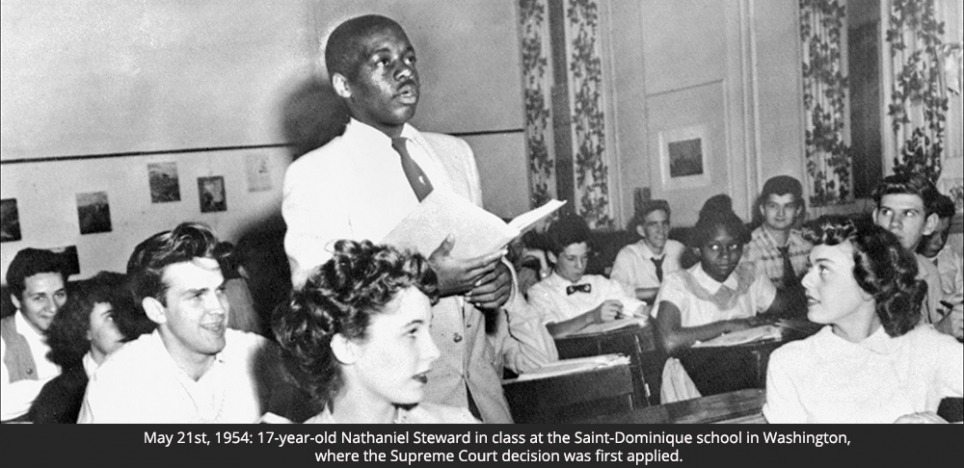Brown v. Board of Education of Topeka was a landmark 1954 Supreme Court Decision and a watershed event in American history. It marked a turning point in the civil rights movement.
The justices ruled unanimously that racial segregation of children, known as "separate but equal" education, in public schools was unconstitutional.
The case began in Kansas in 1951 when Oliver Brown filed a class-action suit against the Board of Education after his daughter was denied entrance to Topeka's all-white elementary schools. Brown claimed that schools for black children were not equal to white schools and that segregation violated the 14th Amendment which includes the clause that no state can "deny to any person within its jurisdiction the equal protection of the law."
By the time the case reached the Supreme Court, it had been combined with four others. Thurgood Marshall, who would later become a Supreme Court justice, argued for the plaintiffs. The justices ruled unanimously that racial segregation of children in public schools was unconstitutional.
 Video
Video
Separate But Equal, now available on DVD, is a four-hour miniseries which aired on ABC Television Network in 1991. With polish and some top-drawer performances, this drama explores the poignant events leading up to the landmark 1954 Supreme Court decision.
Sidney Poitier stars as Thurgood Marshall, chief counsel for the NAACP Legal Defense Fund; Burt Lancaster plays John W. Davis, the attorney arguing the case for separate but equal schools; and Richard Kiley is featured as Chief Justice Earl Warren whose leadership is critical to the Supreme Court's unanimous decision.
This drama directed by George Stevens from his own screenplay offers a thought-provoking portrait of three heroic men who were instrumental in the effort to achieve equal rights for blacks under the law. It also provides a composite portrait of the brave men and women who fought to achieve parity in the early days of the civil rights struggle. And, last but not least, the story delivers a realistic glimpse of the Supreme Court.
 Spiritual Practice
Spiritual Practice
The argument "separate but equal" was dredged up years ago to justify the segregation of schools, restaurants, hotels, and even churches by race. These concerted efforts by whites to maintain their self-perceived superiority over African-Americans brought suffering and humiliation to many people. In 1954 the cry for justice was heard by the Supreme Court, where the justices and the public learned about the malevolent power of segregation as a weapon to harm and shame blacks.
In all the religions and spirituality movements, separation is seen as the source of all the troubles which afflict us. The walls dividing people today have gotten taller and more numerous, whether between blacks and whites, the rich and the poor, the developed and developing worlds. Yet the spiritual yearning for unity persists. There is a part of all of us that wants to live in peace and respectful harmony — neighbor with neighbor, communities with communities, and nations with nations.
As Henri J. M. Nouwen wrote in Bread for the Journey: "Only when we have the courage to cross the road and look into one another's eyes can we see there that we are children of the same God and members of the same human family."
In Leap Before You Look, Arjuna Ardagh shares a spiritual practice to help us move beyond separation:
"Our usual habit is to feel everyone and everything as separate, and therefore to act and speak strategically. As long as we are caught in the grip of separation, even when we are trying to be altruistic, we are still driven by the obsession with 'me.' How do I fulfill my needs? What am I feeling? How can I express my truth? It is, in fact, this underlying feeling of separation that causes us suffering in relationships, more than who said or did what to whom.
"Sit opposite someone close to you.
This could be your intimate partner, or a friend.
Look into each other's left eye.
Look not just at your partner's eye, but through the eye,
into that which is looking back at you.
In this moment, something, someone is looking back at you.
What is that?
What is looking back through this eye and seeing you?
Stay present.
Keep the gaze with this left eye and keep inquiring,
Who am I meeting here?
Who is looking back at me?
What is it, who is it, I am meeting here?
Deeper than thoughts,
Deeper than feelings,
Who is this other?"
